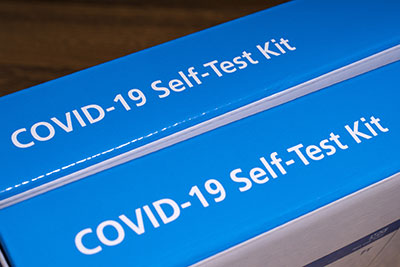COVID tests for business are an important way the economy can start to rebuild from the pandemic. If your business cannot all be done from home, if you have a production facility or specific tasks that must be completed in work premises, then read on.
On February 8th, the Government announced the launch of bringing testing programmes closer to SMEs by lowering the threshold for from 250 employees to just over 50. If your company falls into this category, what does it mean for you? Should you do it? What are the benefits, what are the costs, what are the practicalities, and of course specifically will it help or hinder your own business?
You can find out details by registering here https://www.gov.uk/get-workplace-coronavirus-tests) and then access the secure folder with all the documentation, you will find plenty of information to read.
COVID Tests for Business
It’s noticeably clear why it is a good thing from NHS T&T’s perspective: they would like to know what is going on outside the NHS: There is already a large amount of testing activity in the private sector, regardless of company size, businesses are regularly testing their employees. What with, how and to what effect is very mixed.
Above all, it is invisible to the national testing system and therefore not available to PHE to use for decision making. Government funded and managed testing has been available for firms over 250 employees, but take up has been very patchy, only 112 organisations have signed up and a large organisation like Transport for London only carried out 2173 by the 29th of January. This is for an organisation of 28,000 staff, so the 28 positive cases identified, were just the tip of an iceberg.
In contrast, a similar testing regime in schools will generate a much larger take-up, in the region of 80-90%. (Testing is limited to staff and vulnerable pupils attending school). In neither case is testing compulsory, but the benefits to a school are much clearer.
Asymptomatic Lateral Flow Testing

Asymptomatic Lateral Flow Testing (aLFT) is a controversial topic but debate around the science behind the test may simply miss the point. The real issue is the cost and upheaval of administration and logistics around the programme vs the benefits. Full disclosure: I do believe that large scale asymptomatic testing is an important part of our arsenal of fighting COVID-19 and rolling it out to SMEs is a bold and useful effort, but before embracing it fully, you need to understand the benefits to your company, not just PHE or NHS Digital, especially since you will bear the brunt of the cost, even if the actual test kit is funded by the government.
It is a wonderful thing how the UK scaled up COVID-19 testing from the initial bottlenecks early in the pandemic. In addition to NHS Test & Trace, at least count there were over 500 independent test providers. There is choice, there is advice and there is a lot of testing now outside the NHS. Price of testing has also dropped, LFT kits are now available for between £5-10, and you no longer need to find a lab, they are calling you.
The problem for Public Health England and NHS Test &Trace is that the results of these are not available to them. They would like a better picture of the private sector, collect information about the circumstances and outcome of the test and in return they will fund the test kits.
However, if you read through the extensive documentation, the disruption could be quite large and dwarfs the cost of free test kits provided: you need to create the physical location for testing, train staff, buy lots of PPE and you may not even know the result of the test unless you set up your own recording system. Setting up workplace testing is covered in 237 pages in the LFT ASYMPTOMATIC TESTING GUIDEBOOK provided to employers.
It assumes that all information is simply submitted to NHS T&T: The Employee registers their details on the LITE registration site, the employer simply submits the result directly into the Log Results site and the employer is left with nothing, potentially not even any visibility of who carried out or missed the test and what the results for each employee was. If the employer wants to keep their record, they need to find a way of doing it themselves.

Spreadsheets?
A note here about the NHS’s fondness of spreadsheets and manual data entry. There is a lot of incredibly detailed information on how each person can type in each piece of information (taking about 6 minutes each time). This is in addition to logging in, selecting your test site, waiting for authorisation. There are spreadsheets mentioned and these are optimised not for system-to-system transfers but people patiently typing the same information repeatedly.
Most employers will have systems that already hold much of this data and would only be too happy to use modern integrations tools they are used to provide it to the NHS. It should all be “point, click”, “collect all results and upload in bulk”. It is not clear, however what the NHS is planning to do about accepting bulk submissions, there is no roadmap published. Such a roadmap (not to mention early availability) will be critical to scaling up.
So, it appears that employers will need to keep their own records so you will need to consider these issues:
1. Privacy and data security
- You need to have clear documentation of what you are planning to do, including recording consent. A person providing a test sample can be deemed to have consented, but it would be more clear if they were presented with a consent form with all information relevant to them
- You need to be systematic. With large numbers of employees, you may choose to undertake random tests, but this requires clarity around who is chosen for testing and when.
- You need use a secure system to protect the data. Avoid programs such as Excel which are not suitable.
- You can use anonymised data to share more widely to analyse your results, finding possible patterns and gain more insight.
- Have a plan for when data is no longer needed and a documented process for it to be destroyed.
2. Avoid potential discrimination
It is essential that any form of discrimination is avoided. Be open and transparent about why and how you would like to test your staff. You can also get advice and/or training on how to communicate sensitively with those most at risk.
3. Additional questions and decisions
Information collected by NHS Test & Trace has several questions that provide useful context for the test results (This is why they are there, of course). This is also valuable information for you so capture this information only once and use it both for your purposes as well as submitting into NHS Test & Trace.
You also need to keep track of who needs to be tested when. E.g., Depending on work patterns, holiday times and many other conditions. You need a system that keeps testing schedules, results and other information in the same place.
4. Manage the testing programme
Most businesses will probably find that their current system for recording HR data is insufficient for these purposes, they need to be extended or additional systems used. In most cases a purpose built COVID-19 testing system will be the best.
5. Communication with your staff
NHS Test & Trace will take care of some of this, but only your employees may need more specific guidance or other information relating to their workplace or shift pattern.
You need a system that makes it easy to ensure that the right people get the right template letters.
6. Persuade people to engage with the testing process
Employees can also benefit from a well-designed and easy to use system. Useful features include.
- View and their own data.
- View and print their own previous results and letters.
- Add a result they obtained somewhere else,
- Record LFT results directly. They can have a stack of test kits at home, carry out the test and only go to work when they get the negative results. Of course, the employer and the NHS will also get it at the same time.
Unfortunately, the system provided by NHS Test & Trace does not do any of this, but it is possible to complement it, such systems are already available. The government funded such solutions via Innovate UK (e.g. WorkScreener COVID Manager mentioned earlier).
In Conclusion
So, what should an SME employer do? Will they consider taking on testing without setting up their own data capture tools? Will they embrace the aLFT programme so that the public and PHE can benefit? The key is finding a way of doing all this with minimal effort and disruption. It is possible, available but an SME employer needs to look at both sides of the coin: the same information can benefit the NHS, Public Health England AND the company at the same time. Do it once, get it right, use the information for our collective benefit.


